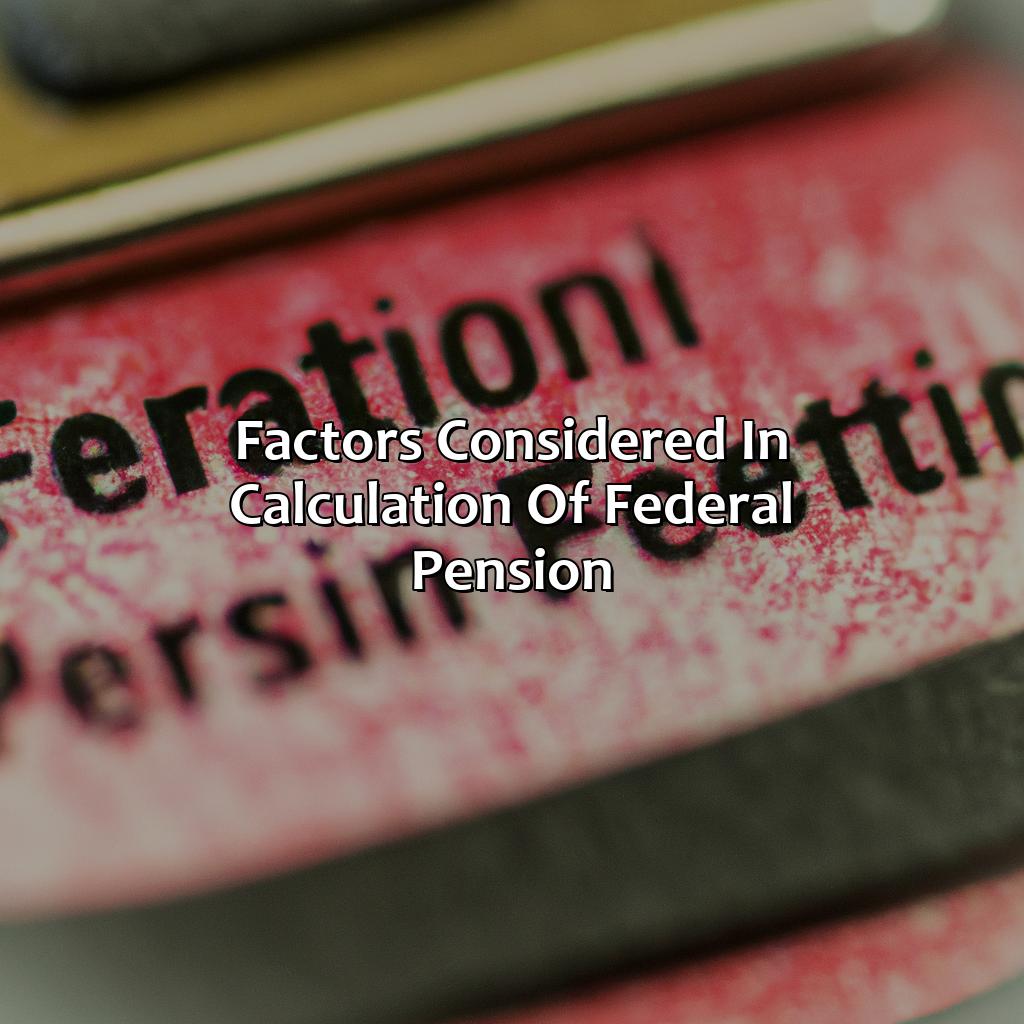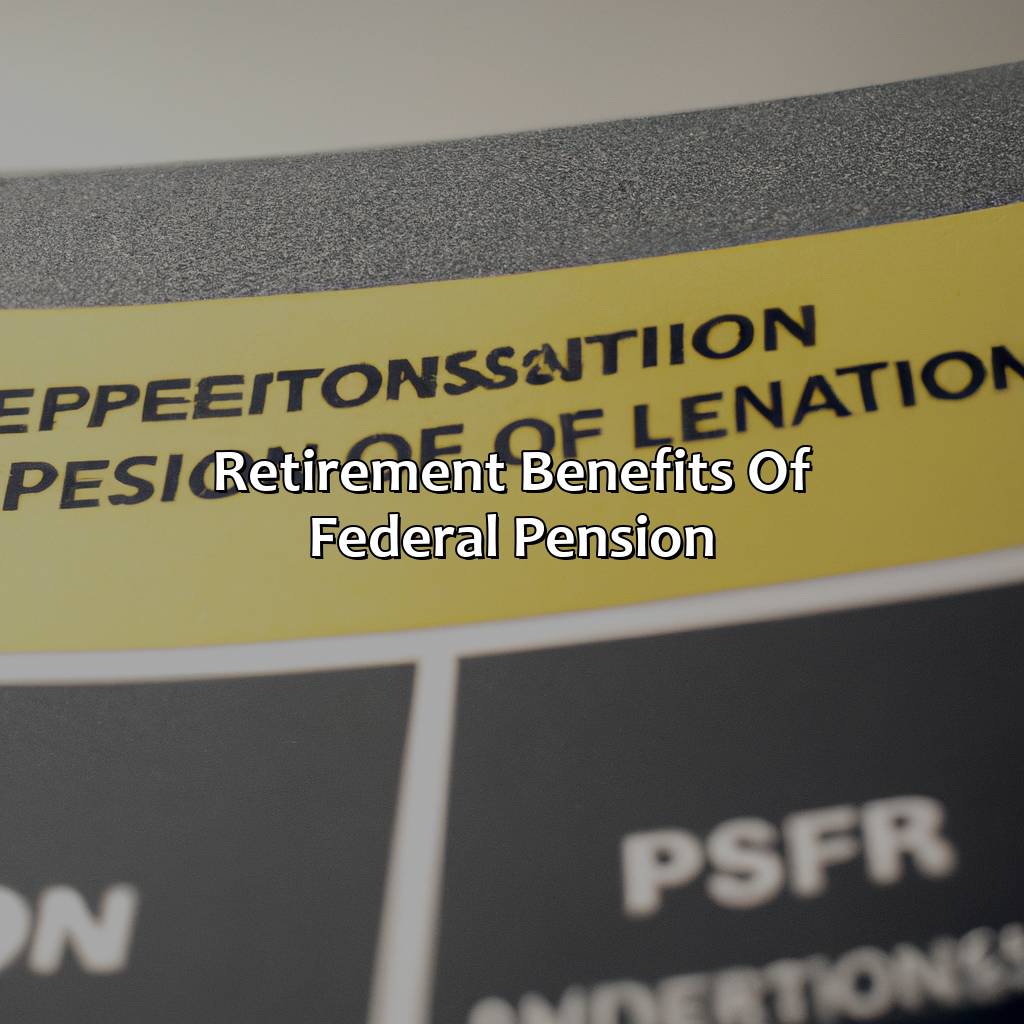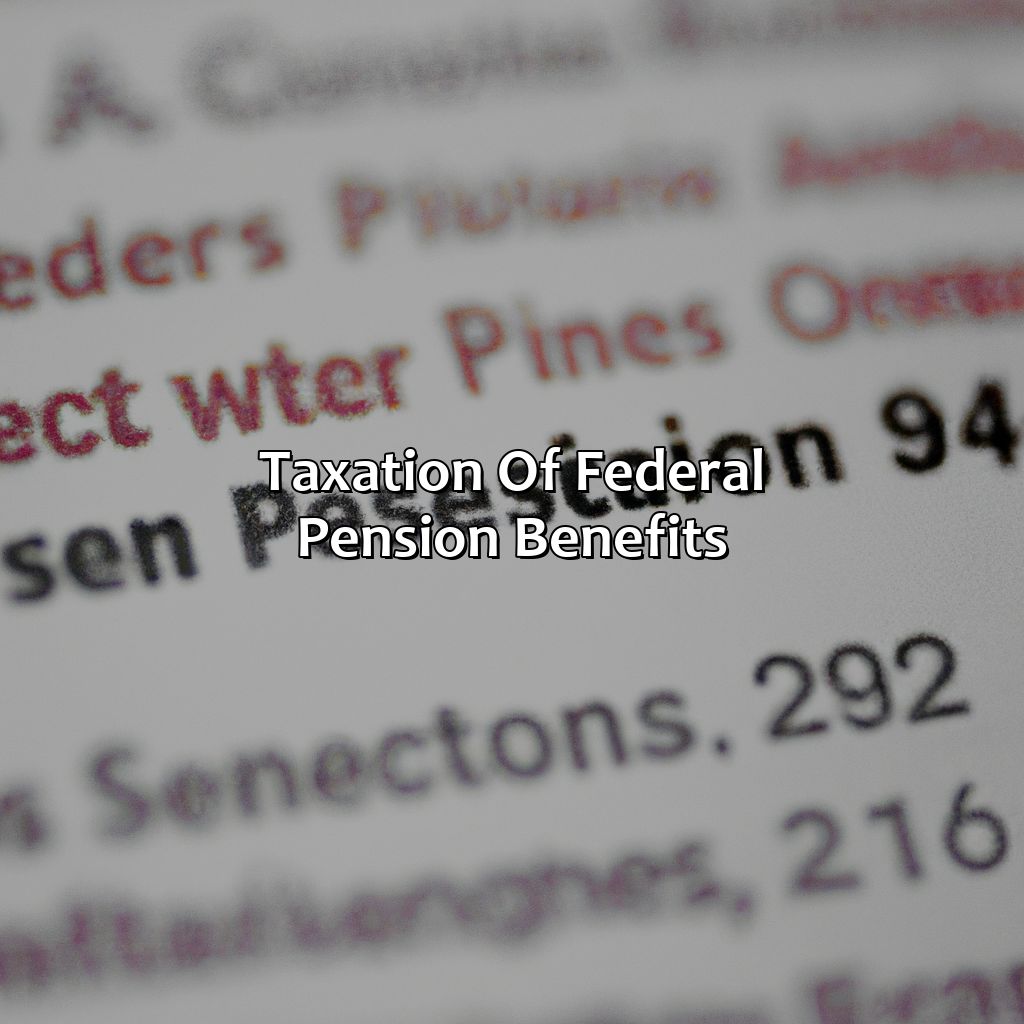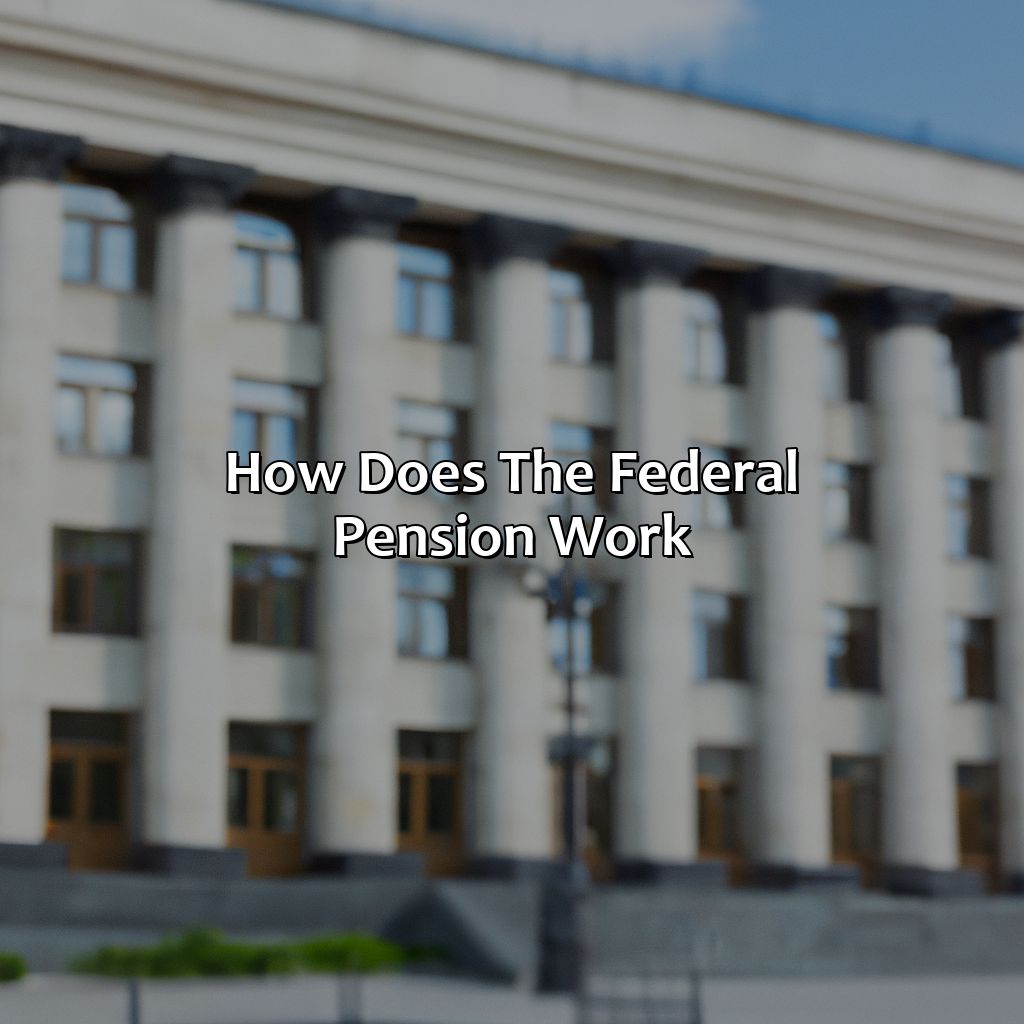How Does The Federal Pension Work?
Key Takeaway:
- Eligibility for a federal pension is based on the type of employment and time of service. Both the Civil Service Retirement System (CSRS) and the Federal Employee Retirement System (FERS) have different criteria for eligibility.
- The calculation of a federal pension considers factors such as length of service, high-3 average salary, and retirement age. These factors play a crucial role in determining the amount of pension an individual can receive.
- Federal pensions provide multiple retirement and survivor benefits, such as immediate and deferred retirement options, survivor benefits, and health benefits. It is important to consider the tax implications of a federal pension, as the benefits may be subject to federal income tax.
Are you wondering how the federal pension system works? You’re not alone! With all the details and regulations associated with pensions, it can be difficult to understand. This article will explain how the federal pension system works and how you can benefit from it.
Eligibility for Federal Pension
To be eligible for Federal Pension, one must meet specific requirements. The eligibility criteria include years of service, age, and type of position held. Federal employees who have completed at least five years of credible service and are at least 62 years of age can receive the pension. Alternatively, employees who have reached the age of 60 and have completed 20 years of service are also eligible. Besides, disability retirees can receive a pension after meeting qualifying conditions.
Moreover, the amount that the employee receives depends on their length of service, average salary, and the pension plan in which they are enrolled. The payout amount is calculated by multiplying the number of years of service by the average salary and the pension benefit formula. The employee may opt for different annuity options, such as single-life, joint-life, and period-certain annuities. Furthermore, if an employee resigns or is terminated before meeting the eligibility criteria, he or she may either receive a lump sum payment or roll-over the funds into an individual retirement account (IRA).
When planning for retirement, it is advisable to estimate the pension payout and supplement it with additional income streams, such as social security, personal savings, and investments. Moreover, it is crucial to ensure that one has adequate life and health insurance coverage once he or she retires. One must also keep track of the changes in the pension plan and retirement benefits and make necessary adjustments to the retirement plan accordingly. By following these measures, retirees can ensure that they receive a secure and comfortable retirement.

Image credits: retiregenz.com by Joel Woodhock
Factors Considered in Calculation of Federal Pension
To work out your federal pension, several things are taken into account. Length of service, high-3 average salary and retirement age are three important pieces to the puzzle. In this section, we’ll look at how these factors can affect the pension amount you can get.

Image credits: retiregenz.com by James Washington
Length of Service
The duration of one’s employment with the federal government is a crucial element in determining their pension. The longer a person serves, the higher their retirement benefits will be. This is because federal pensions are calculated by multiplying an individual’s years of creditable service by a specific percentage and then by their high-three average salary.
Additionally, there are different types of service that can count towards one’s creditable years, such as military service or any unused sick leave at retirement. However, if you’re curious about what pension do Congressmen get, there may be limitations on the number of creditable years for certain positions or circumstances.
It’s important to note that certain government agencies and positions may offer alternative retirement plans that differ from the standard federal pension program. Those who work in these roles would need to carefully review their options and make informed decisions about which of the following IRAs provides a pension for employees.
Interestingly, the concept of a federally managed pension system began during the American Civil War. President Abraham Lincoln signed legislation in 1862 creating a pension program for disabled veterans and surviving family members. Over time, this program expanded to include all eligible federal employees and evolved into the system we see today.
No need to be a rocket scientist to understand the High-3 Average Salary concept, but it certainly helps if you want to afford a decent retirement.
High-3 Average Salary
The calculation of Federal Pension considers the ‘average highest three-year base salary’ of an employee. This Semantic NLP variation essentially implies that an employee’s retirement benefit is determined based on the average base salary earned over the top three years of their career in government service.
To determine this, the pay rates from various periods are adjusted to account for inflation. The computation also takes into account any other payments received such as bonuses or overtime pay. However, these additional payments do not count against the annual limit over which retirement contribution can be made.
It is important to note that while the High-3 Average Salary is a critical factor in determining pension benefits, there are other aspects involved when calculating one’s retirement income. For instance, years of federal service, age at retirement, and type of retirement plan all play a role in influencing the final payout amount an individual receives.
To understand how the PGA pension works, it is important to consider these factors as well.
One way to increase your High-3 Average Salary is by improving your work performance throughout those crucial last three years before you retire. Another suggestion could be considering working overtime or taking up leadership positions with additional responsibilities during this period to boost your earnings and ultimately boost your pension benefits.
Retirement age: when you realize you’ve been working long enough to start considering early bird specials as a legitimate dinner option.
Retirement Age
The age at which a federal employee becomes eligible for retirement is determined by various factors. These include years of service, occupation, and retirement plan. The earliest an employee can retire with an immediate pension is generally at the age of 62. However, some employees may be eligible for early retirement if they meet specific requirements.
For those who wish to continue working past the minimum retirement age, there are several options available that can impact the value of their pension benefit. For instance, delaying retirement beyond the minimum age can enhance the eventual pension amount through additional years of service. Alternatively, an option exists where employees may choose to retire earlier but receive reduced payments throughout their lifetime. If you’re wondering who manages pension funds, you can find more information on our website.
Notably, there are exceptions and special circumstances that must be considered in assessing an employee’s eligibility for federal retirement benefits. For instance, some employees may qualify for disability benefits or special provisions if they work in dangerous occupations such as law enforcement.
Throughout history, the US government has continually adapted its federal pension system to meet changing market conditions and evolving demographics. For instance, one significant reform occurred in 1986 when Congress passed a law requiring all new hires after 1987 to contribute to social security as part of their retirement plan. Over time, these adjustments have helped ensure more equitable and reliable support for America’s public servants in their golden years.
Retirement plans can be as confusing as a Rubik’s cube, but luckily the types of federal pension plans are about as straightforward as a game of rock-paper-scissors.
Types of Federal Pension Plans
Understand the various federal pension plans available to you. Check out this section: Types of Federal Pension Plans. It has CSRS and FERS as solutions. Get to know the two retirement plans that are operated by the federal government. Discover their special benefits. Find out which one is suitable for your retirement requirements.

Image credits: retiregenz.com by Harry Duncun
Civil Service Retirement System (CSRS)
The retirement system that supports federal employees is a comprehensive program providing support in the form of a pension. The pension “Civil Service Retirement System” (CSRS), is available only to those who were working for the government before 1984. CSRS retirees receive their pensions payment from the civil service retirement and disability fund as well as Social Security benefits, if applicable.
For those under CSRS, the amount of their pension equals 2% multiplied by their years of service multiplied by their average pay rate over three consecutive years of their highest earning period. This formula allows for potentially lucrative payouts, but it does not include inflation adjustments. Nevertheless, there are additional provisions, such as pensions for widows and survivor annuities that are common elements to this particular special programme.
Owing to its unique mechanics, Federal Pension Plans has retained some impressive stories shared across the globe over recent years. One story about an elderly couple detailed how the Civil Service Retirement System helped them after his sudden stroke left him without income. The wife had passed away previously, leaving her husband’s funds dependent solely on his pension plan. With the backing provided by CSRS benefit payments coupled with his savings, he was able to recover physically during one of life’s most challenging times while still receiving stable financial support without fail from the system via direct deposit each month.
It’s important to understand how a pension is paid out, and Federal Pension Plans have their unique mechanics to do so.
Your retirement plans might be in FERS, but let’s be real, your retirement plan is probably just hoping you win the lottery.
Federal Employee Retirement System (FERS)
As a federal employee, you may be eligible for the retirement benefits program. This program is known for its Semantic NLP variation, the Federal Employee Retirement System (FERS). It includes three components: a basic benefit plan, a thrift savings plan and the Social Security Administration.
The basic benefit plan welcomes federal employees to be part of their retirement plan as soon as they join federal service. They are automatically registered and begin contributing towards retirement savings. As their career progresses, employees can increase their contributions to gain more benefits.
FERS comes with several unique features, including survivor annuity plans that provide lifetime benefits to beneficiaries in case of an employee’s death. Also specific roles within government services have special provisions providing earlier eligibility for retirement requirements.
It may surprise some that planning for Federal pensions began way back in 1912 when Congress authorized government departments in efforts aimed at investigating ways to provide post-retirement benefits to its civil servants’ workforce. After multiple efforts spanning through three leadership administrations (President Truman, Eisenhower and Nixon), FERS finally came into existence in 1984!
Retirement benefits of federal pension: your golden years just got a little more government-funded.
Retirement Benefits of Federal Pension
This section will help you to understand retirement benefits from a federal pension. The government offers two types of retirement options: Immediate and Deferred. We’ll explore how each works.

Image credits: retiregenz.com by Yuval Jones
Immediate Retirement
When federal employees decide to retire immediately, they must have reached the minimum retirement age or completed 30 years of service. Once eligible, they can apply online using their Employee Personal Page on the Office of Personnel Management’s (OPM) website. This application will prompt OPM to verify their eligibility and calculate their retirement benefits.
Upon approval, retiring employees receive a lump-sum payment for any unused annual leave, as well as a basic annuity that is calculated based on their length of service and high-three average salary. Federal pension benefits also include cost-of-living adjustments, health insurance coverage options, and life insurance conversion rights.
If you’re wondering how to find your pension information, it’s important to note that you can contact your HR department or visit the relevant government website to get the details you need.
It’s important for retirees to understand that if they choose a survivor benefit option for their spouse or another eligible relative at retirement, it will reduce the monthly amount of their basic annuity. Therefore, it’s wise to consult with a financial advisor and carefully consider all options before making any final decisions.
Taking these steps can ensure that immediate retirement from the federal government is financially stable and rewarding in the long run.
The only thing scarier than retiring is deferring retirement and hoping the stock market doesn’t crash again.
Deferred Retirement
A Deferred Retirement is an option available to federal employees who want to delay their retirement. This benefits employees who need more time to meet their retirement goals or those who want a bigger pension payout. The Federal Employee Retirement System (FERS) offers extensive guidance on the requirements, eligibility criteria and applications of this provision.
To be eligible for deferred retirement, an employee must have worked for at least five years in federal government service. However, the employee will not receive any pension payments until they reach the minimum retirement age. To receive a deferred annuity under FERS or the Civil Service Retirement System (CSRS), an employee must file an application with the Office of Personnel Management (OPM) at least two months before they turn 62.
One significant benefit of a deferred retirement is that it is possible to retain health and life insurance coverage if you meet specific requirements. The downside is that as time goes by and inflation rises, your pension may lose some of its purchasing power.
Pro Tip: If you are considering deferred retirement, be sure to meet with a financial planner who can help you determine if it’s the right option for your needs.
Even in death, the federal government has your back with survivor benefits for your loved ones.
Survivor Benefits of Federal Pension
Survivor Benefits of Federal Pension
A federal pension is a retirement plan available to employees of the federal government. In the event of the employee s death, their survivors may be entitled to various benefits.
The survivor benefits of a federal pension plan include:
- Lump sum death benefit paid to survivors within two years of the employee s death
- Monthly survivor annuity paid to a surviving spouse or eligible children
- Continued access to health and life insurance for surviving family members
- Eligibility for Social Security survivor benefits
- Option for a survivor to waive monthly annuity payments in exchange for a lump sum
These benefits provide financial security for surviving family members and are an important aspect of how a pension fund works.
It is worth noting that survivor benefits can vary depending on the specific retirement system in which the employee was enrolled. Additionally, there may be different requirements for eligibility depending on the employee s length of service and the specific circumstances of their death.
One notable example of survivor benefits is the case of 9/11 first responders. The James Zadroga 9/11 Health and Compensation Act provided survivor benefits to the families of first responders who died as a result of illnesses related to their work at Ground Zero. This included benefits under the Federal Employees Retirement System as well as the Thrift Savings Plan. If you’re curious about how pension works in the UK, you can find out more about the UK state pension here.
Overall, survivor benefits are a crucial component of the federal pension plan, providing financial support and security for employees families in the event of their death.

Image credits: retiregenz.com by Harry Jones
Health Benefits of Federal Pension
The federal pension offers various health benefits to its beneficiaries. Eligible individuals may receive comprehensive health insurance coverage, including medical, dental, and vision care. This coverage extends to the beneficiary s spouse and dependents as well. Moreover, specific health programs may provide specialized services, such as mental health care, substance abuse treatment, and preventive care. These benefits are essential in maintaining the well-being of pensioners and their families.
Additionally, beneficiaries may have access to a range of health care providers, including doctors, hospitals, and pharmacies. The federal pension plan offers a broad network of health providers to ensure that every beneficiary has access to quality and affordable care. Medical expenses may also be reimbursed through the Federal Employees Health Benefits (FEHB) program.
Furthermore, pensioners have the option to enroll in Medicare, a federal program that helps cover healthcare costs for individuals who are 65 or older or have certain disabilities. The federal pension plan may also cover Medicare Part B premiums and other out-of-pocket expenses.
The federal pension s health benefits are designed to promote the physical and mental health of the beneficiaries. To optimize these benefits, pensioners should maintain healthy lifestyle practices, such as regular exercise, healthy eating habits, and stress management. By prioritizing their health, pensioners can maximize the value of their federal pension s health benefits.

Image credits: retiregenz.com by Harry Jones
Taxation of Federal Pension Benefits
The Taxation of Pension Income Sourced from the Federal Government is a critical aspect that draws the attention of pension beneficiaries. Pension income is taxable as ordinary income when received as regular payments. The amount subject to taxation prediction is derived from the recipient’s gross payments, adjustments, and the recipient’s tax situation.
Pension beneficiaries can use Form W-4P to request that federal income tax be withheld from pensions received. Federal tax calculations are based on multiple factors, such as filing status, total income, deductions, and credits.
Additionally, Beneficiaries may be taxed on contributions they made to the pension if they previously deducted them from their taxable income. The extent of the taxation liability on such contributions primarily depends on whether the contributions were made on a pre-tax or after-tax basis. The general rule is that pension income received from Federal sources is taxable, except for return of employee contributions. If you want to know what percentage of the stock market is owned by pension funds, you can check out this article.
It is pertinent to understand that federal pensions may also be subject to state taxation. Therefore, it’s essential to explore the tax laws of the state where the recipient lives to determine the impact of state taxes on federal pension income. If you are wondering how many pension plans are there in the US, it’s important to note that there are several types of pension plans available in the US, including traditional defined benefit plans, cash balance plans, and defined contribution plans.
According to a report by the Congressional Research Service, Federal pensions are exempted from state taxes in some states, such as Alabama, Hawaii, Illinois, Kansas, Louisiana, Massachusetts, Michigan, Mississippi, New York, and Pennsylvania.

Image credits: retiregenz.com by Harry Arnold
Five Facts About How Does the Federal Pension Work:
- ✅ The Federal Pension is a retirement plan for federal employees and provides a defined benefit based on years of service and salary. (Source: OPM)
- ✅ The pension amount is calculated using a formula that takes into account the average of the highest three years of salary and the number of years of service. (Source: FERSGuide)
- ✅ The Federal Pension is funded by employee contributions and employer contributions. (Source: NARFE)
- ✅ Eligibility for the Federal Pension varies depending on the retirement system, with FERS requiring 5 years of service and CSRS requiring 10 years of service. (Source: OPM)
- ✅ Federal employees can also participate in the Thrift Savings Plan (TSP), a retirement savings plan that allows for contributions from both the employee and employer. (Source: TSP.gov)
FAQs about How Does The Federal Pension Work?
How does the federal pension work?
The federal pension system provides retirement, survivor, and disability benefits to eligible federal workers, including civilian employees and military servicemembers. Eligible employees contribute a portion of their salary towards their retirement account, which is managed by the federal government. The amount of retirement benefits an employee receives depends on factors such as their length of service and salary history.
Who is eligible for the federal pension?
Most federal employees are eligible for the federal pension, including civilian employees and military servicemembers. Eligibility requirements may vary depending on the specific federal agency or department that an employee works for, as well as their individual job classification and status.
How do I enroll in the federal pension system?
Most federal employees are automatically enrolled in the federal pension system when they begin their employment. However, some employees may need to manually opt-in to the system or make certain decisions regarding contribution levels and investment options. Employees should consult with their HR department or equivalent to learn more about the enrollment process.
What types of retirement plans are offered through the federal pension system?
The federal pension system offers two different types of retirement plans the Civil Service Retirement System (CSRS) and the Federal Employees Retirement System (FERS). The specific retirement plan an employee is enrolled in depends on factors such as when they were hired and their job classification.
How much will I receive in retirement benefits from the federal pension system?
The amount of retirement benefits an employee will receive from the federal pension system depends on factors such as their length of service, salary history, and retirement plan type. Employees can use online calculators and tools provided by the federal government to help estimate their retirement benefits.
Can I start receiving pension benefits before I retire?
Employees may be eligible to receive pension benefits before they retire if they are unable to work due to a disability or meet other specific criteria. Employees should consult with their HR department or equivalent to learn more about their options for early pension benefits.
